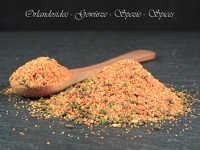
Seasonings – the Art of Blending Spices
Definition
Seasonings are thoughtfully composed blends of spices and herbs. Every country and culinary tradition has developed its own profiles over centuries, passing recipes from generation to generation.
Craft & Tradition
Creating a great seasoning demands knowledge of spice families, a refined palate and the courage to experiment. Across cultures, this craft has evolved into regional signatures that reflect local tastes and ingredients.
Regional Examples
Africa: Explore iconic blends such as Harissa, Berbere, Raz el Hanout, Tsire.
India: Dive into a classic curry, discover Masala, or explore single spices like cardamom.
How to Use Seasoning Blends
- Bloom in fat: Warm a little oil or ghee and briefly toast the blend to release aroma.
- Dry rubs: Coat meat, fish or vegetables before grilling, roasting or pan-searing.
- Marinades: Mix with oil, yogurt or citrus for deeper penetration and tenderness.
- Finishing touch: Sprinkle lightly at the end to refresh aroma in soups, grains or salads.
- Adjust to taste: Balance heat, salt and acidity (lemon, vinegar) as needed.
Refining & Personalizing
Use ready-made blends as a base and tailor them: add chili for heat, citrus peel for brightness, or toasted seeds for nutty depth. Keep notes on ratios you enjoy—this is how family favorites are born.
Storage
Store blends in airtight containers away from light and moisture. For peak aroma, use within 6–12 months; whole spices last longer than ground.
FAQ
Are seasoning blends always spicy?
No. Some focus on warmth and aroma (e.g., cinnamon, coriander), while others emphasize chili heat.
Can I substitute one blend for another?
Often yes, but expect a different character. Start with less and adjust as you taste.
Do I need to add salt?
Many blends are salt-free; season separately to control salinity. If a blend contains salt, reduce added salt accordingly.



